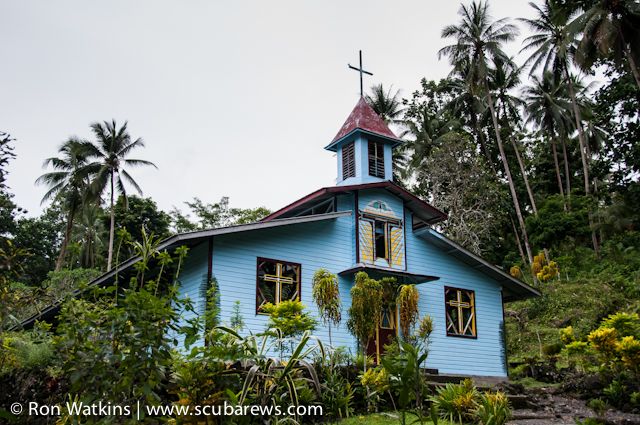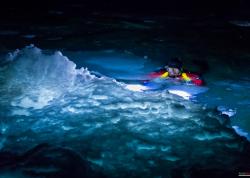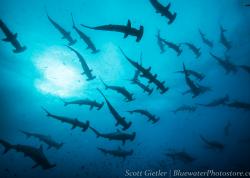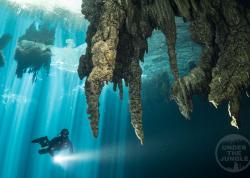Diving Papua New Guinea, Part II: Macro
Diving West New Britain, Papua New Guinea on the MV Febrina
An underwater photographer's unique and spectacular experience diving in the PNG
Part II: Macro, topside and cuttlefish
By Ron Watkins
Continued from Part I: Sharks and wide-angle opportunities like never before
World-Class Muck Diving
Despite the plentiful wide-angle opportunities, I switched to macro on several dives and found no shortage of subjects. The reefs and pinnacles play host to soft coral crabs, transparent shrimp, scorpionfish, leaffish, anemonefish, blennies, crinoids shrimp, saron shrimp and a wide variety of nudibranchs. Digger also found several boxer crabs that carry small anemones in their claws and use them to fend off predators. I think they look more like cheerleader crabs with pom-poms. There is also world-class muck diving at Garove Island in the black sand of Dicky’s Place, which rivals that of Lembeh and other areas throughout Indonesia. I could have stayed another day or two, as there were so many unique species in the muck. Keen-eyed Digger also found Halimeda pipefish, robust pipefish, a tiny Green Oxynoe sea slug, porcelain crabs on anemones, an anemone hermit crab, different varieties of lionfish, false clown anemonefish, and sea cucumbers with numerous small shrimp and crabs on them. One unique discovery was the robust pipefish with a baby squid attached to its tail. Here are a few of the macro images taken, but you can see more of my super macro images in the article Learning Super Macro Photography in PNG.

Robust pipefish with a baby squid attached to its tail

A rare saron shrimp hunting at night

A boxer crab extends his anemones in defense

A soft coral crab blends in perfectly with his host

A family of false clown anemonefish settles in for the night along with a few shrimp

A pink anemonefish peaks out into the darkness from the safety of his host

An Anemone hermit crab on the blank sand of Dicky’s Place
The Beautiful People of Balangore
Upon arrival to Garove Island we picked up an interesting old plantation owner named Dicky, who was hitching a ride back to Kimbe Bay. Dicky is Anglo, but was born in Rabaul, married a local girl and still lives with his extended family in the village. It had been six months or so since he had been out of the village so he was very happy to be on the boat and talking with all of us. His stories about PNG, the people, WWII wrecks and his friend Paul Allen were very entertaining.
In between the afternoon and night dives, Dicky gave us a private tour of Balangore, where his wife was raised. At the center of the village is huge grassy field, which provides a central meeting place as well as an area for the children to play. At one end of the field is Balangore Primary School. We walked through the residential area and met with many of the local residents. The children are adorable and love to have their picture taken and then see what they look like in the camera. The women weave palm leaves for their roofs, scrape coconut meat from the shell, prepare copra (their main cash crop) and cook. The men fish, wood carve and cut the palm leaves from the trees. The children help out around the village, swim and play soccer in the field. The tour ended at the opposite end of the field at a community church on the hill. At the end of the tour, we were escorted back to our skiff by an entourage of children who waved goodbye as we returned to the Febrina.

Shy at first

Young boys in Balangore

A young boy from Balangore in his dugout canoe

The Balangore church on the hill
Krackafat and the Cooperative Cuttlefish
The weather continued to improve and the sunrise was beautiful through the partly cloudy sky. We were able to dive four more times in the Witu Islands, with spectacular dives on Barney’s Reef and Krackafat. Alan Raabe discovered most of the dive sites, installed moorings and named them. Many were named after family members or friends, but I had to ask about what Krackafat meant. The Aussies let out a big laugh and informed me that there is a saying about "cracking a fatty," which means getting an erection. Alan says that this dive site is so good that when you surface, you will understand the true meaning of the site’s name. The site was appropriately named, and the origin of name gives you some insight into Alan's colorful humor.
Krackafat is covered with huge barrel sponges, clusters of soft coral, gardens of red sea whips and with moderate currents come huge schools of large fish. The icing on the cake was a very cooperative foot-long cuttlefish that I spent most of the dive practicing my close-focus wide-angle photography technique on. Digger and I followed it all over the reef as it passed in front of colorful soft corals and sponges changing color and shape for camouflage and in an attempt to communicate with us. It allowed us to get extremely close and at times reached out to touch the dome port of the camera in an inquisitive way. They are truly remarkable animals and I feel very fortunate for our time spent together.

Cuttlefish posing on the reef with a large school of fish

Same cuttlefish turning changing colors

A large soft coral provides a good hiding place for the cuttlefish

A large stand of red sea whips
Father’s Reef and The Arch
The Febrina traveled 100 miles the next night to Father’s Reef and we woke up on Norman’s Wall. Shortly into the dive I was concentrating on getting the eyes and claws of a transparent shrimp in the same focal plane when I felt something nudge my arm several times. Thinking that Digger had found another amazing subject, I looked up to find a large hawksbill turtle in my face, curious about what I was looking at. He continued to stick his beak into my business, so I decided that maybe he wanted his picture taken. I flipped back the diopter, adjusted the aperture, shutter speed, and strobes and took a few macro turtle shots. Then we found several other small shrimp, crabs, a leaffish and several nudibranchs to photograph.

The hawksbill turtle who wanted his picture taken

Tiny red spider crab with coral polyps growing on him

A leaffish with a tiny green nudibranch on his dorsal fin

One of the many nudibranchs seen in PNG
The next dive was back to wide-angle at The Arch, which is a large underwater arch reef formation and swim through at 90 feet. There is a convenient reference line close to the mooring that leads you down to the arch. I got down there first to set up some shots, but quickly the other divers appeared and filled up the arch so I pulled back and allowed them to pass through. Then Digger went on the other side of a smaller piece of the arch that had some beautiful sea fans and posed with his light.

Digger poses above The Arch

A red sea fan adorns the side of The Arch
Why Papua New Guinea Diving Is So Special
Despite the bad weather causing us to skip a few dives, I was still able to log 31 dives in the 7.5 days of diving. In addition to the previously highlighted dives in this article, the diving at all of the sites is consistently good and each offers a wide variety of wide-angle and macro photography opportunities. Shaggy’s Reef, Leslie’s Knob, Elaine's Reef, Jane’s Gully, Killibob's Knob and Kirsty Jane's are all signature dive sites of this North Coast New Britain itinerary. Each site uniquely delivers on healthy reefs, stunning pinnacles, prolific marine life and biodiversity that will impress even the most seasoned diver and underwater photographer.
The cooperative cuttlefish on Krackafat, like most of the marine life in these remote areas, are not used to interactions with divers and are easily approached if you move slowly. On nearly every dive in PNG there are curious turtles that appear to enjoy their reflection in the dome port, or fearless sharks that come in very close and brake off only at the last minute. One puppy-dog-like white tip bumped me several times and even head butted an unsuspecting diver. Schools of barracuda and trevally numbering in the hundreds will allow you to approach them and enter their inner sanctum as if they are protecting you. Even the typically shy anemonefish seem curious enough to leave the protection of their host and pose for pictures. One reason for this behavior is that there are currently only two full time dive boats in PNG, so some of the sites only get visitors a few times a year. Alan said that most of the boats that were in PNG have either gone bankrupt or relocated to more popular markets like Raja Ampat, Indonesia. We never saw another dive boat on the entire trip, except for Paul Allen’s private yacht the Octopus. Much of the trip we were diving in the protected waters of a Nature Conservancy sponsored marine park. The strict level of enforcement, which is rare in remote parts of the world like PNG, is well publicized and serves as a warning. Alan shared a story of a foreign commercial fishing vessel that was seized by the government, the crew imprisoned and the company levied a heavy fine. The ship was held in quarantine for over a year and eventually returned, but only after it had been completely stripped of everything of value onboard. This type of enforcement will hopefully keep the area pristine for many years to come.
After returning, I was asked by a fellow diver and underwater photographer if I thought the diving in Papua New Guinea is really worth all of the time and expense to get there. I responded without hesitation that it absolutely is worth it and I would again dive on the Febrina. My only regret is that I did not stay longer to explore other areas of the country and experience more of their colorful culture. I definitely plan to return in the near future, so stay tuned for the next chapter of my Papua New Guinea travel adventure.

The sun sets behind an erupting volcano
About the Author
Ron Watkins is an international award winning photographer and writer. He has been passionate about underwater photography since 1996 and his photography has appeared in magazines, websites, juried art displays, national aquariums, libraries and private collections. Additional images from this trip and many others may be viewed at www.scubarews.com.
Further Reading
Support the Underwater Photography Guide:
The Best Service & Prices on u/w Photo Gear
 Visit Bluewater Photo & Video for all your underwater photography and video gear. Click, or call the team at (310) 633-5052 for expert advice!
Visit Bluewater Photo & Video for all your underwater photography and video gear. Click, or call the team at (310) 633-5052 for expert advice!
The Best Pricing, Service & Expert Advice to Book your Dive Trips
 Bluewater Travel is your full-service scuba travel agency. Let our expert advisers plan and book your next dive vacation. Run by divers, for divers.
Bluewater Travel is your full-service scuba travel agency. Let our expert advisers plan and book your next dive vacation. Run by divers, for divers.
RECOMMENDED ARTICLES
SUPPORT THE UNDERWATER PHOTOGRAPHY GUIDE:
The Best Service & Prices on u/w Photo Gear
 Visit Bluewater Photo & Video for all your underwater photography and video gear. Click, or call the team at (310) 633-5052 for expert advice!
Visit Bluewater Photo & Video for all your underwater photography and video gear. Click, or call the team at (310) 633-5052 for expert advice!
The Best Pricing, Service & Expert Advice to Book your Dive Trips
 Bluewater Travel is your full-service scuba travel agency. Let our expert advisers plan and book your next dive vacation. Run by divers, for divers.
Bluewater Travel is your full-service scuba travel agency. Let our expert advisers plan and book your next dive vacation. Run by divers, for divers.































